Introduction
As of June 2023, the app store on Shopify has evolved into a critical component of the global eCommerce market. It has emerged as a vibrant hub for online businesses, playing a pivotal role in driving eCommerce sales and equipping online merchants with a wide range of applications to enhance and personalize their eCommerce stores.
Analysis overview
This article provides an in-depth examination of essential metrics and Shopify stats related to the eCommerce industry and the app store. Our goal is to illuminate the growth, user engagement, and language diversity of this platform.
Data coverage
Our analysis covers data on the number of apps launched per year since 2009, user reviews posted on these apps, the total number of partners associated with these apps, and the languages supported by the apps on the app store.
Aim and insights
By scrutinizing these metrics, we aim to offer valuable insights into the evolution of the app store, its attraction to developers and users, and the strides made to cultivate a vibrant and inclusive ecosystem.
Key Shopify statistics
As of June 2023, Shopify powered over 4.28 million live stores or so-called Shopify users.
There are 32.990 Shopify Plus stores across 175 countries as of July 2023.
Shopify revenue reached $5.90B in the twelve months ending March 31, 2023, with 22.31% growth year-over-year.
There are 8.500+ Shopify apps on the official app store.
More than 800.000 reviews have been published over the years on the store.
Over 5.600 Shopify partners have at least one app on the store.
81% of the Shopify traffic comes from mobile devices.
The majority of Shopify stores are from USA and UK.
The top Shopify stores categories are fashion and apparel.
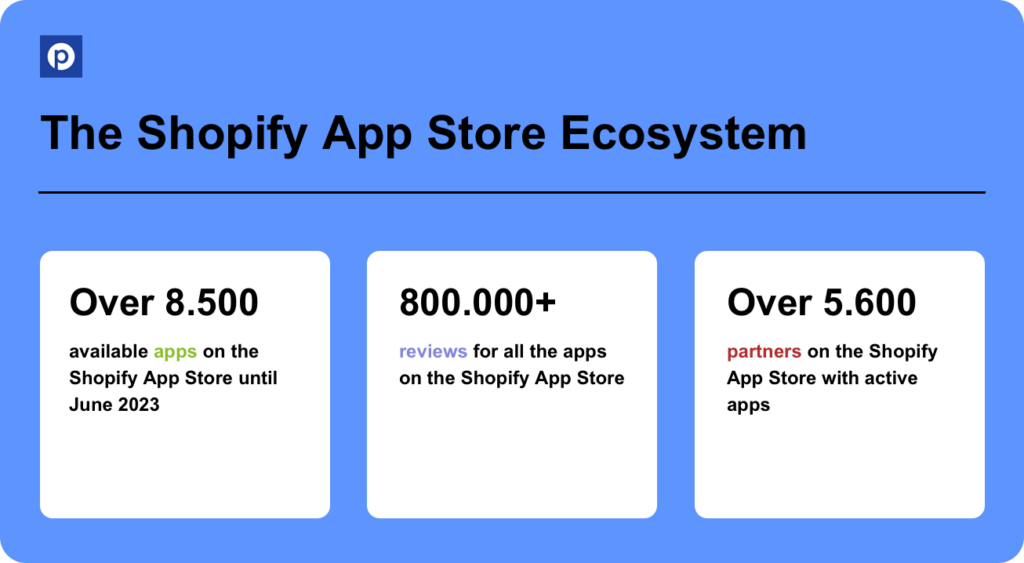
Shopify apps
The app store has grown significantly since 2009, with over 8.500 apps available until June 2023. This growth demonstrates the platform’s appeal to developers and its ability to attract innovative applications. The increase in app launches from 2020 to 2023 highlights the importance of the app store as an integral part of the Shopify ecosystem, providing Shopify merchants with the flexibility to customize and optimize their Shopify store further.
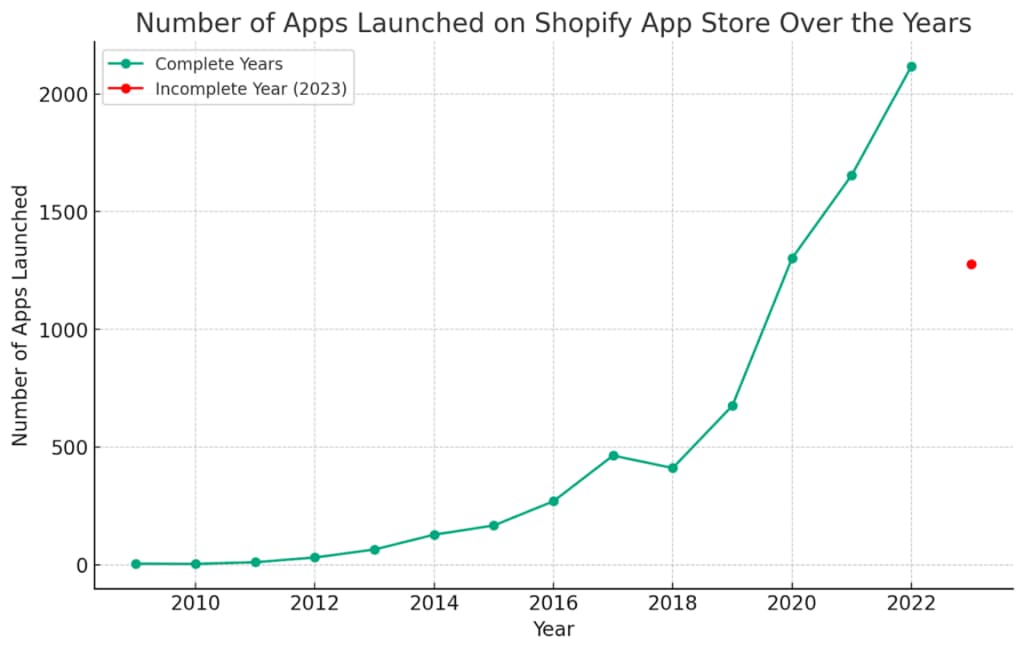
Exponential growth in apps
The data reveals a remarkable growth trajectory in the number of apps launched each year. In the initial years, from 2009 to 2011, the number of apps remained relatively low, reflecting the platform’s nascent stage and limited developer engagement. However, from 2012 onwards, the growth became exponential, indicating an increasing interest from developers in building applications for Shopify.
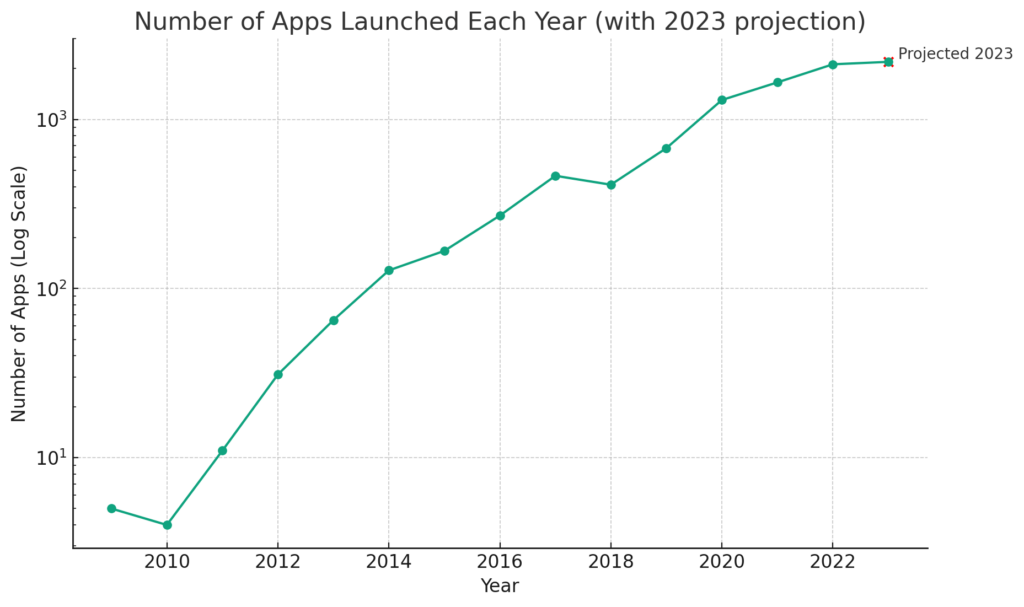
Catalysts for growth
Several factors contributed to the significant increase in app launches. Shopify’s growing popularity as a popular eCommerce platform and its expanding merchant base likely attracted more developers to create apps to meet the increasing demand for enhanced functionalities. Additionally, Shopify’s efforts to improve the app store’s infrastructure, documentation, and developer support played a crucial role in encouraging app development.
Inflection points
The data shows two distinct inflection points in app launches.
The first occurred in 2014 when the number of apps surpassed 100, signifying a considerable milestone in the app store’s growth.
The second inflection point took place in 2019, when the number of apps more than doubled compared to the previous year, reaching an impressive 676 apps.
Fluctuations and stabilization
While the growth has been mostly exponential, there were fluctuations in the number of apps launched in certain years. For instance, in 2018, there was a slight dip in the number of apps, but it stabilized in the subsequent years. These fluctuations could be attributed to changes in Shopify’s policies, app store guidelines, or external market factors influencing developer interests.
Surge between 2020 – 2023
The period from 2020 to 2023 witnessed unprecedented growth, with over 3.900 new apps being launched in just four years. This remarkable surge suggests that the app store has become a thriving ecosystem for developers, catering to a wide range of merchant needs and preferences.
Quality vs. quantity
While the number of apps is a significant metric, it is equally important to assess the quality and relevance of these apps. Not all apps may have achieved sustained success, and some might have been discontinued or become obsolete over time. A deeper analysis of user reviews, ratings, and app retention rates would provide valuable insights into the app store’s overall effectiveness.
As the app store continues to expand, it is essential for Shopify to maintain a balance between quantity and quality, ensuring that developers have the necessary tools and support to create valuable and sustainable solutions for merchants.
Reviews of Shopify apps
In addition to the number of apps launched per year, an essential metric for analyzing the Shopify app store’s performance and user engagement is the number of reviews posted on these apps. This section aims to provide a thorough analysis of the reviews on apps in the Shopify app store from its inception in 2009 up until the current year, 2023.
By delving into the trends and patterns in user reviews, we can gain valuable insights into the level of satisfaction among Shopify online store owners and users and the overall quality of the apps available on the platform.
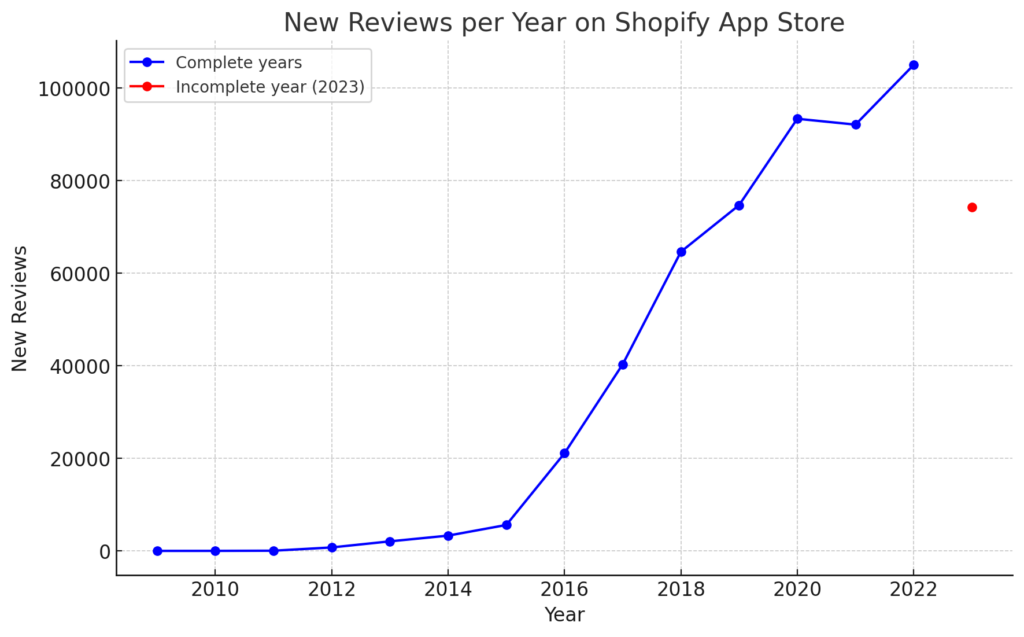
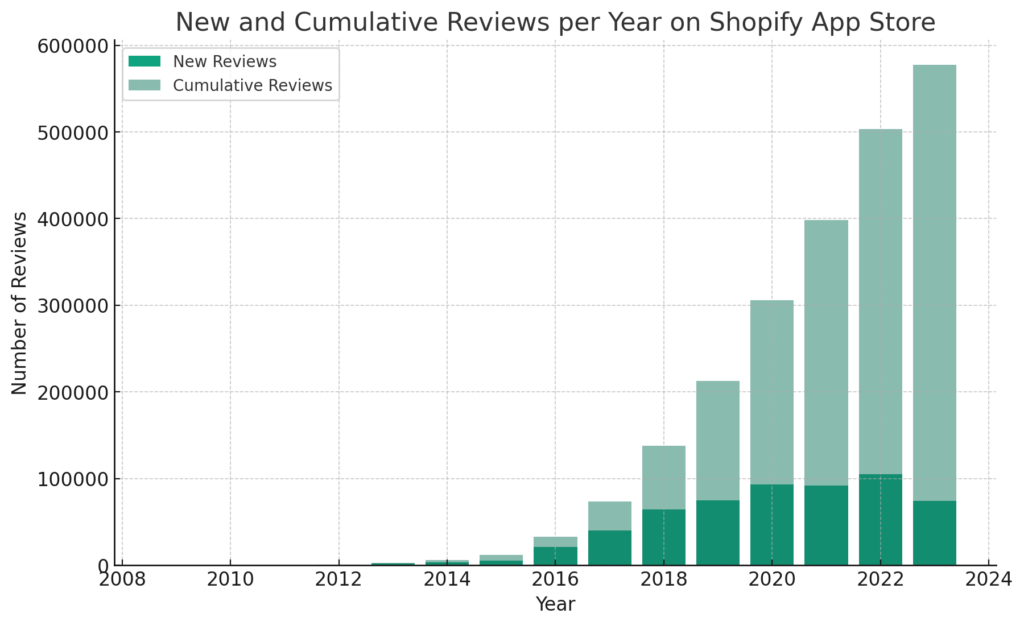
If we apply a simple and common method for a projection of the total reviews for 2023 by using linear regression, which assumes that the trend of increasing reviews will continue in a linear fashion, we can have the following chart.
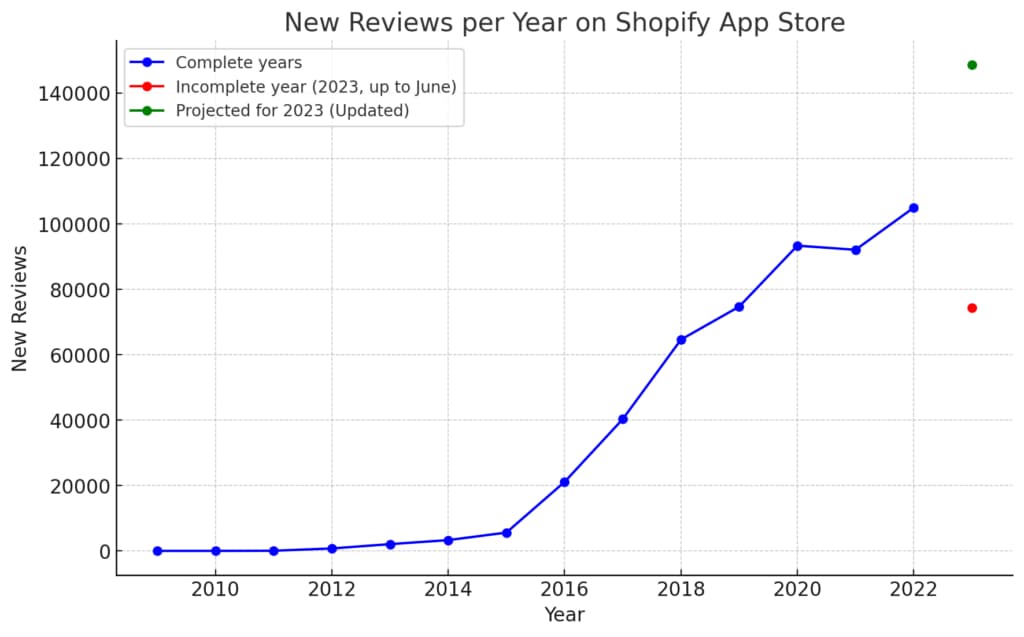
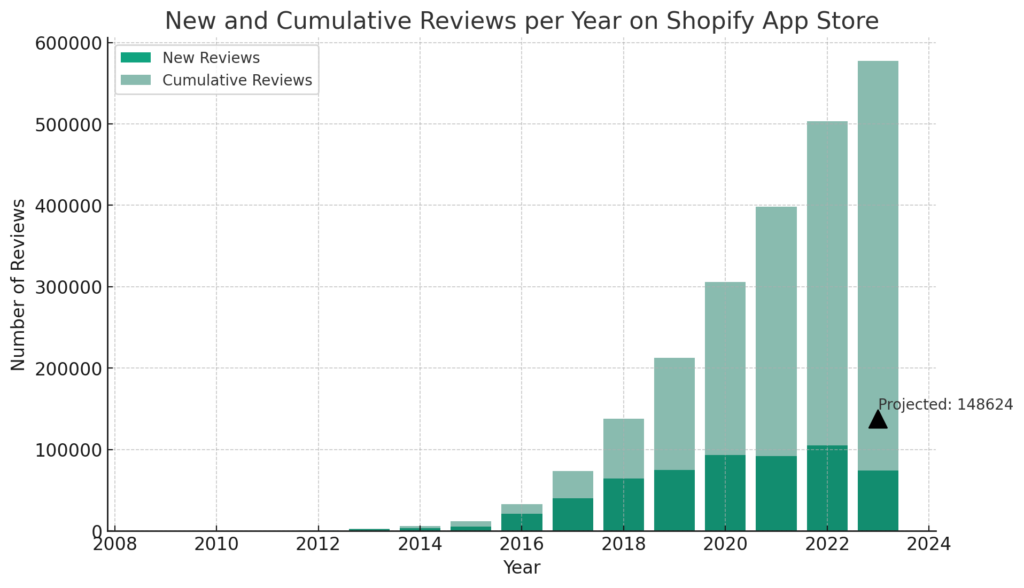
Please note that our projection of total reviews for 2023 may be affected by a recent update from Shopify. Starting from July 10, 2023, there will be a slight delay between the submission and publishing of new app reviews on Shopify’s app store. This is part of Shopify’s commitment to increase the quality and trustworthiness of reviews by proactively detecting and preventing potentially fake reviews. Therefore, the actual number of reviews may vary from our projection due to this change in the review publishing policy.
Early years’ reviews
In the early years of the Shopify app store (2009 to 2011), the number of reviews posted on apps was relatively modest, with an average of fewer than 30 reviews per year. This limited number of reviews can be attributed to the platform’s nascent stage, a smaller user base, and the availability of a more limited selection of apps.
A rapid increase in reviews
The year 2012 marked a significant turning point, with a substantial increase in the number of reviews posted on apps. This trend continued through 2015, indicating a growing user base and a higher level of engagement with the available applications. As the app store expanded its offerings, users had more options to choose from, leading to increased interaction and feedback.
The peak in reviews
The period from 2016 to 2018 witnessed a remarkable surge in the number of reviews posted on apps. In 2016, the reviews surpassed 21.000, and by 2018, they exceeded 64.600 reviews. This exponential growth in user feedback demonstrates a rapidly maturing app store, indicating the increasing popularity and relevance of the platform in the eCommerce industry.
Stability and high engagement
From 2019 to 2022, the number of reviews remained consistently high, ranging from around 74.000 to over 104.000 reviews. This stability in review counts suggests that Shopify’s app ecosystem has maintained its engagement with users over the years, reflecting a sustained level of satisfaction and interest in the applications offered.
Reviews during 2023
As of the current year, 2023, the number of reviews on apps stands at approximately 74.300. While this figure may not have surpassed the peak seen in 2022, it still represents a substantial volume of user feedback, indicating a continued healthy user base and a vibrant app store.
Quality of reviews
Evaluating the quality and sentiment of user reviews is essential in understanding users’ experiences with the apps. Detailed sentiment analysis would provide valuable insights into app satisfaction levels, common pain points, and areas for improvement. Higher-rated and positively reviewed apps are more likely to attract new users and contribute to a positive app store experience.
Analysis of the distribution of the reviews
The analysis of the distribution of the reviews in the Shopify app store provides valuable insights into user engagement and satisfaction levels with the available applications. The data categorize reviews into three groups based on the number of reviews posted on apps: 0-10 reviews, 11-30 reviews, and 31+ reviews. Let’s examine each category in detail.
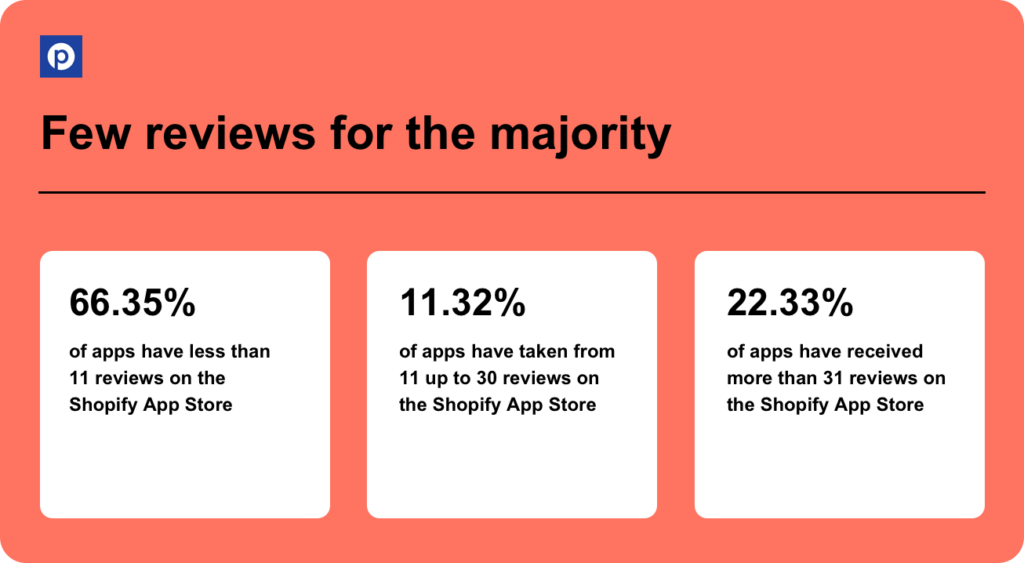
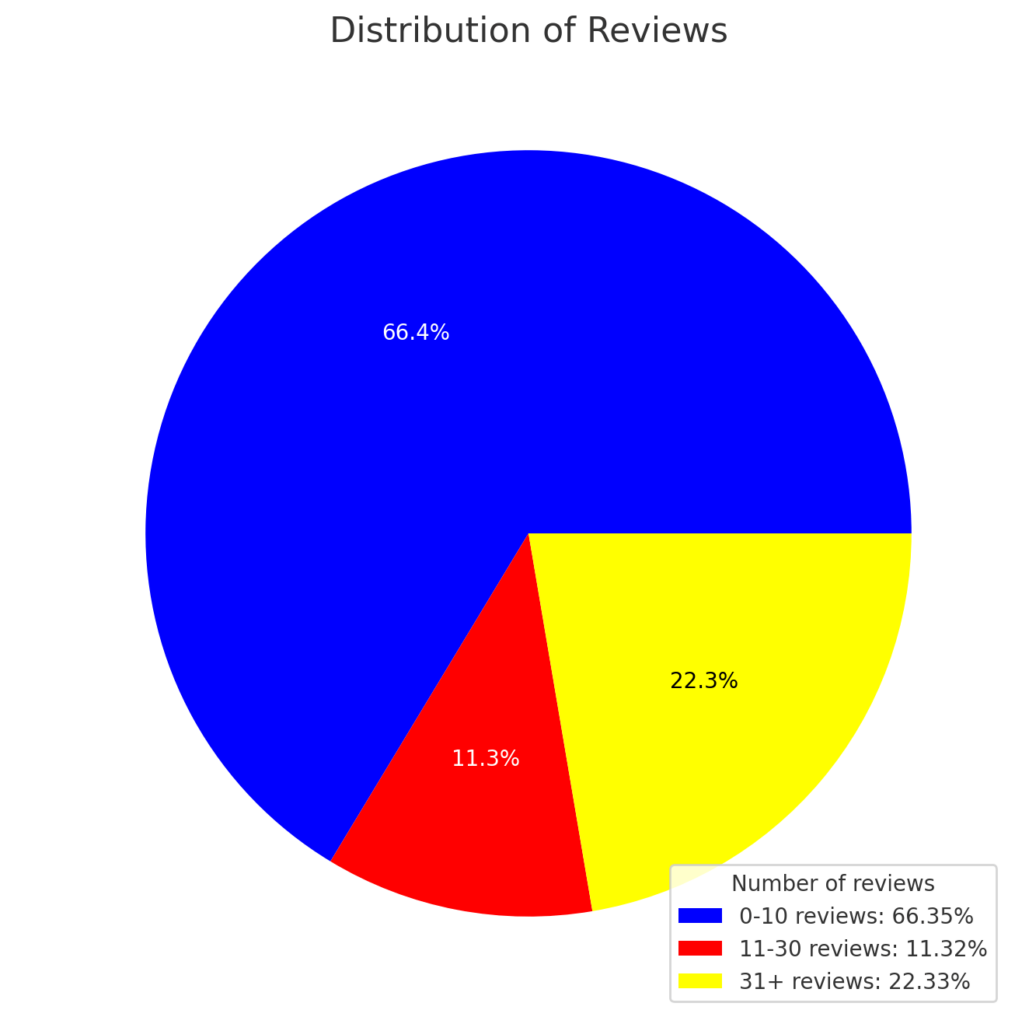
The majority of apps have few reviews
According to the data, the majority of apps which is 66.35% on the app store, have between 0 to 10 reviews. Apps with fewer reviews could be relatively new additions to the app store or apps that have not yet gained significant traction. It could also indicate that some apps may not actively encourage users to leave reviews or haven’t effectively engaged their user base to provide feedback.
A significant number of apps have moderate reviews
The next group consists of apps with 11 to 30 reviews, making up 11.32% of the total. Apps falling in this range have managed to attract a moderate number of reviews, which could suggest a higher level of user engagement and satisfaction compared to the previous category. These apps might have gained some popularity among users, leading to a modest increase in the number of reviews.
A considerable portion of apps have numerous reviews
The last group is apps with more than 31 reviews, accounting for 22.33% of the total. Apps in this category are likely more established, widely used, and have garnered a higher level of user attention and feedback. A larger number of reviews usually indicate a higher user base and overall satisfaction with the app’s functionality and features.
Implications
App quality and popularity
The distribution of reviews suggests that a substantial portion of apps in the app store have received limited user feedback. This could indicate that a considerable number of apps may still be in the early stages of development or have not been widely adopted by users. Developers of such apps may need to focus on improving the quality, functionality, and marketing efforts to attract more users and gather feedback.
User engagement
Apps falling into the 11-30 reviews category demonstrate a moderate level of user engagement. These apps have likely attracted a user base and managed to encourage some users to provide feedback. However, there is still room for improvement to increase the app’s popularity and garner more user reviews.
User satisfaction
The apps with 31+ reviews, forming more than one-fifth of the app store, have shown strong user engagement and satisfaction. These apps have succeeded in delivering value to users, resulting in higher user adoption and willingness to provide feedback. Their popularity may be attributed to superior functionality, regular updates, and responsiveness to user needs.
The app store has varying levels of user engagement and satisfaction with available applications. Most apps have fewer than ten reviews, indicating a need for increased user engagement and marketing efforts. Some apps have garnered a significant number of reviews, suggesting successful user adoption and satisfaction.
Developers should continuously improve app quality, engage users for feedback, and actively respond to user needs to enhance the overall satisfaction and popularity of their apps. Positive reviews, regular updates, and effective marketing strategies contribute to the growth and success of the Shopify app store ecosystem.
The number of reviews on apps in the app store is an indicator of user engagement and satisfaction. From 2012 to 2015, there was a rapid increase in reviews, followed by a peak from 2016 to 2018. Review counts remained stable from 2019 to 2022, showing Shopify’s ability to maintain high user engagement.
To sustain user satisfaction, high-quality apps and addressing user feedback are critical, along with regular sentiment analysis and responding to user reviews. Analyzing apps and reviews can provide a comprehensive view of the app store’s growth, effectiveness, and user satisfaction.
Relationship between apps launched and reviews posted
Here’s the scatter plot showing the relationship between the number of apps launched and the number of reviews posted each year.
You can observe a positive correlation between the two variables. This suggests that as the number of apps launched increases, the number of reviews posted also tends to increase. However, please note that correlation does not imply causation and further analysis would be required to determine any causal relationships.
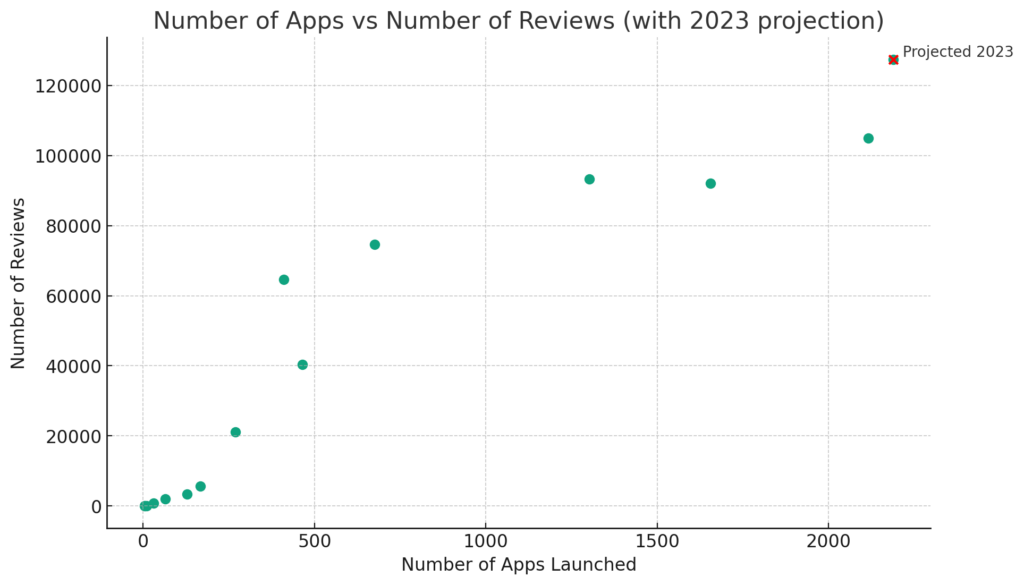
Analysis of partners
The data provided showcases the distribution of total partners associated with the apps available in the app store. The number of partners represents the developers or companies responsible for creating and maintaining these apps. Let’s delve into the analysis of this metric.
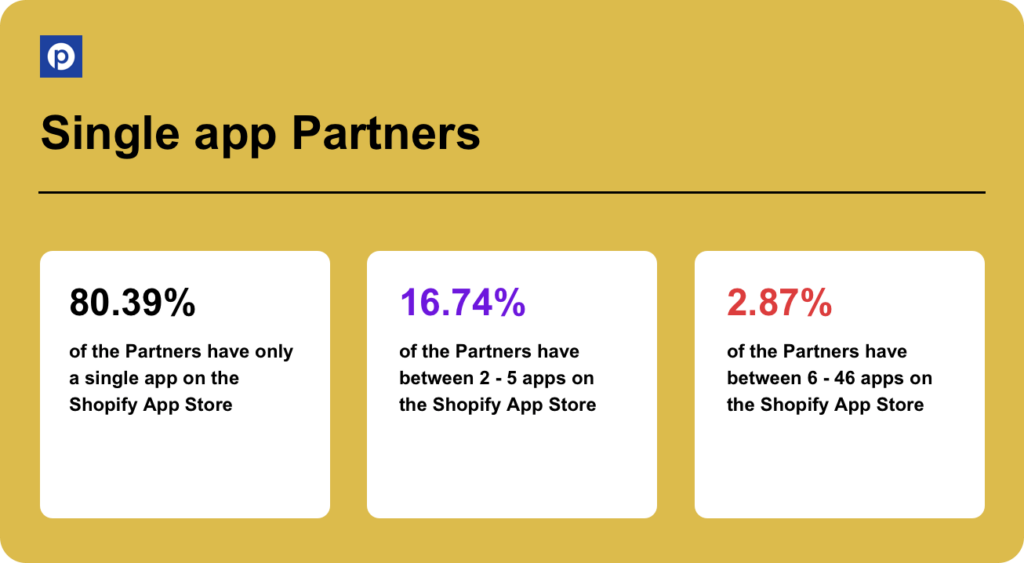
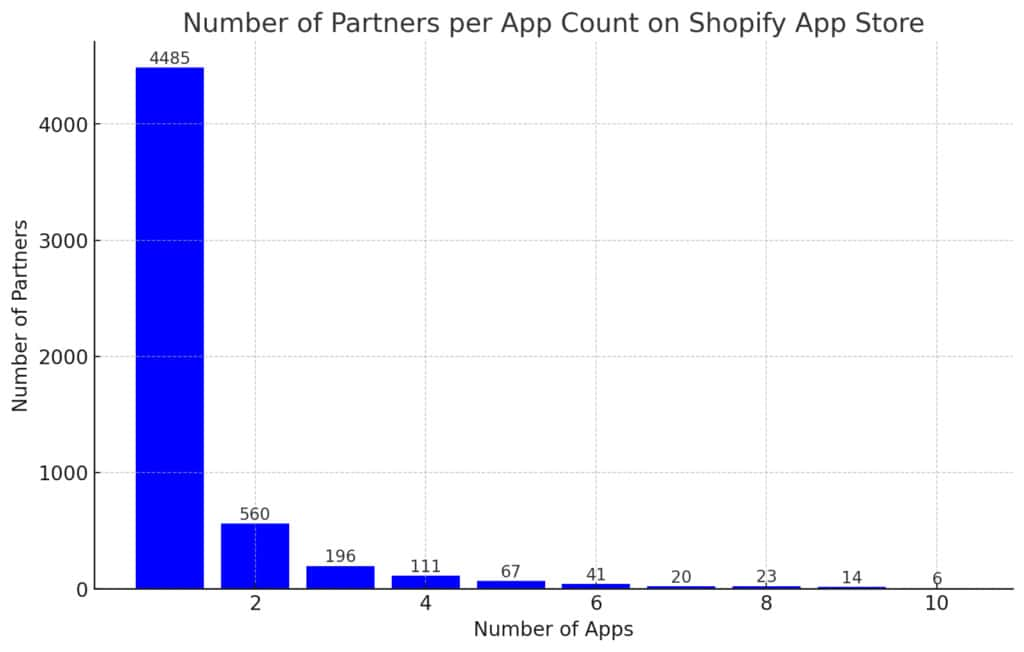
A high percentage of single-app partners
The data reveals that a significant majority of apps (80.39%) in the app store belong to single-app partners. This indicates that the majority of apps are likely developed by individual developers or small companies or large companies that focus on one service/product. Of course, this also highlights the accessibility of the Shopify platform, allowing individual developers to create and contribute to the app ecosystem.
Small teams and collaborations
While most apps have a single partner, there are cases of apps developed by two or more partners. The percentage of apps with multiple partners is relatively low, with the highest being 0.11% for apps with six partners. These collaborations may involve specialized skill sets or joint efforts to create more sophisticated and feature-rich applications.
Power law distribution
The distribution of total partners with apps follows a power-law distribution, where a vast number of apps have only one partner, and as the number of partners increases, the percentage of apps with those partners decreases significantly. This is a common distribution pattern seen in many ecosystems and markets, indicating that a few popular apps may have larger teams or involve more collaborations.
Impact of app popularity
It is reasonable to assume that the most popular and successful apps, with a high number of partners, tend to attract more attention and resources from developers and companies. These apps are more likely to have higher user adoption rates, leading to greater potential revenue streams and opportunities for partnerships.
Diverse developer ecosystem
The distribution of total partners reflects a diverse developer ecosystem within the app store. Individual developers and small companies have significant representation, which fosters innovation and competition. This diversity allows for a wide range of apps catering to different merchant needs and niche markets.
The majority of apps in the app store have only one partner, indicating the accessibility of the platform for individual developers and small teams. However, apps with multiple partners are likely to be more complex and feature-rich.
Maintaining a balance between individual creators and larger teams is essential for a diverse range of apps and fostering innovation. The Shopify app store thrives due to the collective efforts of individual developers, small companies, and collaborative partnerships, creating a dynamic and evolving app ecosystem that benefits merchants.
Languages supported by the apps
The data provided offers insights into the languages that apps support, highlighting the distribution of supported languages and the number of apps offering multilingual capabilities. Let’s analyze the data better to understand the language diversity within the app store.
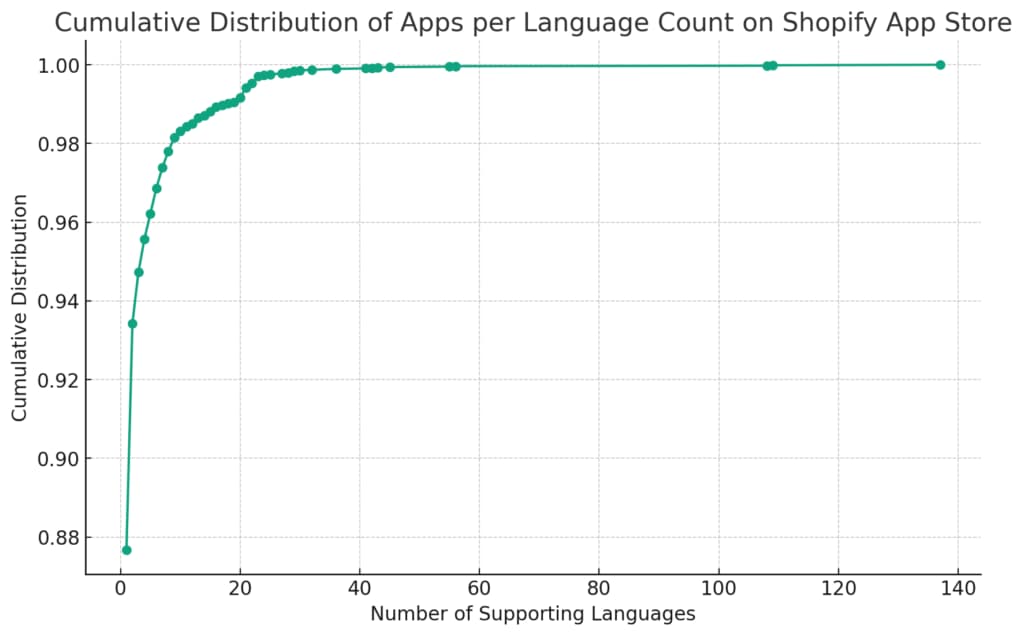
Multilingual support
Out of the total number of apps analyzed (8.613), 7.578 apps (88.24%) support only one language. This suggests that a significant majority of apps in the app store are designed to cater to a specific language-speaking audience, with English being the most prevalent.
English dominance
English is the most widely supported language, with 7.367 apps (85.78%) offering support only for English-speaking users. This highlights the global reach and widespread use of English in the eCommerce and digital business landscape.
Other supported languages
After English, the next most commonly supported languages are Spanish (590 apps), French (573 apps), and German (544 apps). These languages reflect the diverse international user base and the efforts made by developers to cater to users across different linguistic regions.
Apps with multilingual support
Although the majority of apps support only one language, there is still a substantial number of apps offering multilingual capabilities. For instance, 498 apps support two languages, and a smaller number of apps support three or more languages. This indicates developers’ efforts to broaden their app’s user base by accommodating users from various linguistic backgrounds.

Language distribution
The data also provide insights into the distribution of apps based on the number of languages they support. The majority of apps (7.578) support only one language. As the number of supported languages increases, the number of apps supporting those languages decreases. For example, there are 112 apps supporting three languages, 73 apps supporting four languages, and so on.
Implications
Global reach
The prevalence of English support in the majority of apps reflects the international appeal and global reach of the Shopify platform. English serves as the primary language for many online businesses, allowing merchants to target a broader audience worldwide.
Localization efforts
The support for languages other than English (Spanish, French, German, etc.) demonstrates developers’ efforts to cater to specific regional markets and enhance user experiences through localization.
User inclusivity
Apps that offer multilingual support play a crucial role in fostering inclusivity and accessibility for users across diverse linguistic backgrounds. Multilingual capabilities can significantly improve user engagement and satisfaction.
Market expansion
Apps with multilingual support have the potential to expand their market reach and attract a broader user base from different language-speaking regions. This can lead to increased revenue opportunities for developers as well as for online stores.
The app store, catering to a broad base of Shopify customers, offers support for a diverse range of languages, with English being the most dominant. However, in order to optimize Shopify sales and operate successful Shopify stores, there’s a need for further efforts to enhance multilingual capabilities in the app store.
Developers who provide multilingual support can expand their potential user base, promote inclusivity, and contribute to an increase in Shopify sales. Encouraging developers to offer multilingual options will play a crucial role in fostering a truly global and user-friendly app ecosystem, ultimately benefiting both Shopify customers and merchants.
What lies ahead for the Shopify app store?
The Shopify app store, a leading hub for eCommerce business solutions, is projected to sustain its exponential growth due to increasing demand for innovative applications that enhance online stores, including popular Shopify apps.
The high level of user engagement and satisfaction, demonstrated by the substantial number of reviews posted on apps, is expected to attract new users and Shopify store owners to the platform. The inclusivity of the app store, evidenced by its widespread distribution of partners and supported languages, encourages individual developers and small teams to contribute actively to this dynamic ecosystem.
The Shopify app store will continue to serve as a key player in the eCommerce business landscape, empowering merchants worldwide with an expanding range of high-quality merchant solutions. The platform’s future success will hinge on its ability to adapt to changing market dynamics and maintain a competitive edge in the rapidly evolving global eCommerce market.






